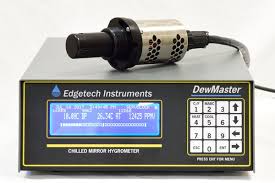In applications where absolute accuracy and stability in humidity measurement are critical, chilled mirror hygrometers stand out as the gold standard. Used extensively in research, industrial processing, meteorology, and quality control, these instruments provide direct, primary measurement of dew point, unlike other sensor-based alternatives.
This in-depth article explores the function, advantages, applications, and considerations of chilled mirror hygrometers, helping you understand why they are trusted for precise humidity monitoring across demanding environments.
What is a Chilled Mirror Hygrometer?
A chilled mirror hygrometer is a scientific-grade instrument designed to measure dew point temperature, corresponding to the absolute moisture content in air or gas. It operates by cooling a reflective surface (mirror) until condensation forms. The temperature at which this happens is known as the dew point and is measured directly.
The chilled mirror hygrometer is often regarded as a primary standard for humidity measurement because it doesn’t rely on indirect estimation or calibration drift like capacitive or resistive sensors.
How Does a Chilled Mirror Hygrometer Work?
Cooling the Mirror
A small mirror within the instrument is cooled using thermoelectric (Peltier) elements. The cooling continues until water vapor in the air condenses on the mirror surface.
Optical Detection
An optical sensor system—typically using a light source and photodetector—detects the onset of condensation on the mirror. When the light beam reflects differently due to water droplets, the system notes the mirror temperature.
Dew Point Calculation
The temperature of the mirror at the moment of condensation is the dew point. This value is highly accurate and directly measurable, not inferred.
Advanced models may also compute relative humidity (RH), frost point, and absolute humidity using integrated temperature and pressure sensors.
Why Chilled Mirror Hygrometers Are Superior
Direct Measurement
Unlike polymer or capacitive sensors that infer humidity from electrical changes, chilled mirror devices measure the actual physical phenomenon of condensation, providing unmatched accuracy.
Exceptional Accuracy
They typically offer accuracy better than ±0.1°C dew point, making them ideal for laboratory, calibration, and critical process control applications.
Stability Over Time
These instruments have minimal drift, ensuring consistent readings without frequent recalibration, vital in long-term monitoring.
Traceability and Standards Compliance
Chilled mirror hygrometers are considered reference standards and are widely used in calibration labs. They are traceable to national metrology institutes like NIST (USA) or PTB (Germany).
Applications of Chilled Mirror Hygrometers
Meteorology and Climate Research
Weather stations and climate monitoring systems use chilled mirror hygrometers for high-accuracy humidity profiles in the atmosphere.
Pharmaceutical Industry
Maintaining precise humidity levels in cleanrooms and production lines is critical for product integrity and regulatory compliance. Chilled mirror systems ensure this precision.
Calibration Laboratories
National and commercial calibration labs use chilled mirror hygrometers as reference instruments to validate and calibrate other humidity sensors.
Semiconductor Manufacturing
Even trace moisture levels in semiconductor fabs can cause wafer defects or yield loss. Chilled mirror hygrometers ensure ultra-dry air and process gases.
Natural Gas and Petrochemical Processing
Moisture in natural gas pipelines can cause hydrate formation and corrosion. Chilled mirror hygrometers help monitor and control dew points to prevent failures.
Food and Beverage Industry
In freeze-drying, packaging, and fermentation processes, chilled mirror systems maintain consistent moisture control for quality assurance.
Types of Chilled Mirror Hygrometers
Single-Stage Cooling Systems
These use one thermoelectric element to cool the mirror and are suitable for moderate dew point ranges (e.g., +20°C to -20°C). They are common in industrial applications.
Dual-Stage or Triple-Stage Systems
These designs employ multiple thermoelectric stages and are used for very low dew points (down to -80°C or lower). They are ideal for ultra-dry environments such as gas drying, cleanrooms, and military applications.
Key Features to Look For
Mirror Cleaning Systems
Some instruments feature automatic mirror cleaning, using mechanical wipers, air jets, or solvent sprays to remove contamination that could affect readings.
Temperature and Pressure Compensation
Built-in sensors allow for real-time correction of readings based on ambient conditions, improving accuracy.
Data Logging and Communication
Modern devices support RS232, Modbus, USB, or Ethernet for integration into SCADA, DCS, or cloud-based systems.
Touchscreen or Remote Monitoring
User-friendly interfaces and web-based dashboards offer remote access and diagnostics, minimizing on-site intervention.
Limitations and Considerations
Despite their advantages, chilled mirror hygrometers also come with some challenges:
Higher Cost
They are significantly more expensive than capacitive or resistive humidity sensors, which may limit their use to high-stakes environments.
Maintenance Requirements
The mirror can accumulate dirt, oil, or particles over time, requiring regular cleaning to maintain accuracy.
Slower Response Time
Compared to fast-acting sensors, chilled mirrors may take several minutes to stabilize, particularly in rapidly changing conditions.
Popular Brands and Models
Some of the most trusted names in chilled mirror hygrometry include:
- MBW Calibration – Swiss precision instruments used globally in calibration labs.
- Michell Instruments – Offers rugged, portable, and lab-grade models.
- GE Panametrics (now Baker Hughes) – Known for petrochemical-grade instruments.
- Vaisala – Combines chilled mirror technology with industrial-grade reliability.
- EdgeTech – Specializes in ultra-low dew point measurement for gas and cryogenic applications.
Best Practices for Use and Maintenance
- Calibrate periodically using certified standards.
- Avoid direct exposure to oil vapors or corrosive gases.
- Use particle filters upstream of gas sampling lines.
- Install in stable temperature environments to prevent condensation from interfering.
- Schedule regular cleaning using lint-free swabs or manufacturer-recommended solvents.
Conclusion
Chilled mirror hygrometers are unparalleled for accurate, traceable, and stable humidity measurement. Though they require a higher initial investment and routine maintenance, their direct measurement capability makes them indispensable in industries where precision and accountability are non-negotiable.
Whether calibrating other sensors, monitoring gas systems, or maintaining environmental stability in critical processes, the chilled mirror hygrometer remains the most reliable and trustworthy tool for absolute humidity determination.
